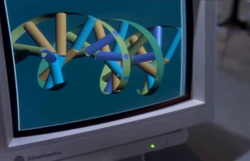
DNA in laboratory
Dinosaur DNA is the key for recreating dinosaurs. In the time that Michael Crichton wrote Jurassic Park and his critics wrote their reviews, nothing about Dinosaur DNA was known. The few DNA sequences that appear in Jurassic Park media are made up. In the 21st century, however, scientists have discovered Dino DNA sequences or other features of their genomes.
This article lists all DNA sequences of dinosaurs (and other prehistoric reptiles) that appear in the Jurassic Park Franchise and sequences discovered by scientists.
This article assumes that you know what these things are:
Genome size[]
In the Showroom Scene, Mr DNA says: "A full DNA strand contains three billion genetic codes!" This quote doesn't make sense at all. What he probably means is: "A full dinosaur genome contains three billion nucleotides."
The genome of an organism is the whole of its hereditary information encoded in its DNA. Genome size is measured in amount of base pairs or picogram (10-15 kg). 1 picogram is roughly equel to 1 billion base pairs.
The size of the human genome is indeed three billion base pairs. Until a complete dinosaur genome is discovered, the size of dinosaur genomes remains unknown. However, Prof. Chris Organ and colleagues have been able to make a good estimation. They discovered that, in extant species, the size of bone cells correlates with its genome size. Genome size explains 60% of the variation in cell size.[1] In fossils the small holes in which the bone cells resided during life are still visible in the mineral matrix. By measuring these small pockets, they were able to predict the genome sizes of Theropods, Sauropods, Ornithischians and Pterosaurs.
Saurischian dinosaurs had small (theropods) to moderate genomes (sauropods). Ornithischians had larger genomes, about the size of other reptiles. However, the average genome size in both groups was still much smaller than "three billion (base pairs)". The genomes of Pterosaurs were also small.
These small genome sizes are good news, they reduce the costs and time needed to sequence and synthesize the dinosaur DNA.
Theropods[]
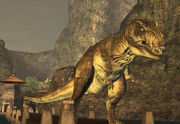
Non-bird theropods had, just like most modern birds, a very small genome. The average theropod genome was 1.78 picogram[1], which is roughly 1.78 billion base pairs. They fall within the narrow range of genome sizes for living birds (0.97–2.16 picogram). Oviraptor is an exception.
Table 1
This table shows the estimated genome size and confidence interval for theropods that appear in Jurassic Park media. Data from Organ et al (2007) supplements.
| Species | Genome size (pg) | Confidence interval |
|---|---|---|
| Allosaurus | 1.7 | 0.002 |
| Coelophysis | 1.7 | 0.0012 |
| Deinonychus | 1.62 | 0.002 |
| Herrerasaurus | 1.47 | 0.0013 |
| Ornithomimus | 1.43 | 0.0033 |
| Oviraptor | 2.53 | 0.0047 |
| Troodon | 1.48 | 0.0027 |
| Tyrannosaurus rex | 1.96 | 0.0043 |
Sauropods[]
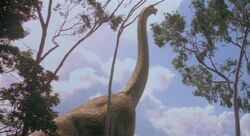
Sauropod
Organ and colleagues estimated the genome size of 10 Sauropodomorphs. The average genome size was ~2.02 billion base pairs (range of species means: 1.77-2.21 picogram).[2] This value is larger than the average of theropods, but it is in the upper range of extant birds (range: 0.97-2.16). This value is also near the average for extant (non-avian) reptiles, which is 2.24 pg (range: 1.05-5.44 pg).
Table 2
This table shows the estimated genome size and confidence interval for Sauropodomorphs that appear in Jurassic Park media. Data from Organ et al. (2009).
| Species | Genome size (pg) | Standard deviation |
|---|---|---|
| Apatosaurus | 2.31 | 0.44 |
| Barosaurus | 1.77 | 0.36 |
| Massospondylus | 2.21 | 0.7 |
| Plateosaurus | 1.82 | 0.30 |
Ornithischians[]
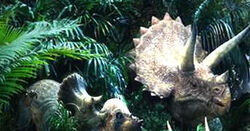
Ornithischian dinosaurs
Organ and colleagues estimated the genome size of 17 ornithischian dinosaurs. Their average genome size was 2.49 pg (~2.5 billion base pairs),[1] which is within the range of modern (non-bird) reptiles like Alligator (2.49 pg), Crocodile (3.21 pg) and monitor lizards (2.05 pg).
Table 3
This table shows the estimated genome size and confidence interval for ornithischian dinosaurs that appear in Jurassic Park media. Data from Organ et al (2007) supplements.
| Species | Genome size (pg) | Confidence interval |
|---|---|---|
| Dryosaurus | 2.47 | 0.0024 |
| Euoplocephalus | 2.88 | 0.0073 |
| Hypacrosaurus | 2.62 | 0.0032 |
| Hypsilophodon | 2.74 | 0.0033 |
| Lambeosaurus | 2.58 | 0.0031 |
| Maiasaura | 2.51 | 0.0029 |
| Orodromeus | 2.47 | 0.0045 |
| Pachycephalosaurus | 2.17 | 0.0033 |
| Protoceratops | 1.74 | 0.0021 |
| Psittacosaurus | 1.81 | 0.0021 |
| Stygimoloch | 2.88 | 0.0047 |
| Styracosaurus | 2.47 | 0.0031 |
| Tenontosaurus | 1.97 | 0.0024 |
| Triceratops | 3.31 | 0.005 |
Pterosaurs[]
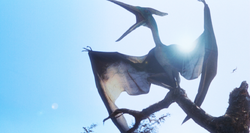
Organ and colleagues estimated the genome size of 4 Pterosaur species. Their average genome size was 2.0 pg (~2 billion base pairs).[3] Pterosaurs had a small genome, just like birds and bats. Therefore, Organ and his team think that a small genome is needed for flight.
Table 4
This table shows the estimated genome size and standard deviation for Pterosaurs that appear in Jurassic Park media. Data from Organ et al. (2009).
| Species | Genome size (pg) | Standard deviation |
|---|---|---|
| Dimorphodon | 1.94 | 0.23 |
| Rhamphorhynchus | 1.93 | 0.25 |
| Pterodactylus | 2.12 | 0.25 |
| Pteranodon | 2.01 | 0.35 |
Chromosomes[]

How DNA is Packaged (Basic)
From DNA to chromosome.
All the DNA of an animal isn't stored in one large strand. Animals have multiple strands of DNA, which form chromosomes. Humans have 23 different chromosomes. Chromosomes differ in size, architecture, amount of genes and biological function.
We don't know what dinosaur chromosomes looked like, since chromosomes don't fossilize. However, a good estimation of dinosaur chromosomes can be made by looking at the evolution of bird chromosomes. It is good to know that Ratites belong to the most primitive order of birds Palaeognathae). The chromosomes of ratites can be compared with the chromosomes of basal archosauromorphs like crocodiles and turtles.
If birds and reptiles have identical genes or chromosome architecture, it can be assumed that this was also the case for the early dinosaurs and those that gave rise to birds.
Microchromosomes are small chromosomes of less than 20 Megabases in size. Microchromosomes are present in birds, some reptiles, fish, and amphibians. They must have been present in dinosaurs.
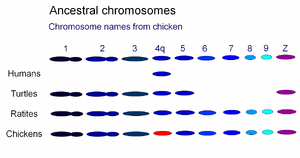
10 ancestral bird chromosomes.
Scientists have compared the chromosomes of many species (using Fluorescence in situ hybridization). Griffin and colleagues summarised the results of the research on bird chromosomes.[4] From these results they were able to deduce what the ancestral bird chromosomes looked like.
Chicken chromosome 4q is identical to chromosomes in ratites, turtles and even mammals. In humans this chromosome is called 4. This chromosome must have existed 310 million years ago, when the last common ancestor of mammals and birds lived. Since then this chromosome was concerved throught evolution. Since both turtles and birds have this chromosome, it is likely that the dinosaurs (that gave rise to birds) also had it.
The same thing can be said about chicken chromosomes 1, 2, 3 and 5 (see figure). All these chromosomes have almost identical counterparts in ratites and turtles. Later in bird evolution these chromosomes broke apart and fused in different ways.
Chromosomes 6, 7, 8, 9 are only present in birds. Therefore, it is unknown whether dinosaurs also had them.
Sex chromosomes[]
The Z chromosome is the sex determining chromosome in birds. However, an identical chromosome is also present in turtles. Despite the fact that the sex of turtles is determined by the eggs incubation temperature. It is unknown what determined the sex of dinosaur. However, dinosaurs must have had the Z chromosome containing the sex related genes. In both Ratites and turtles chromosome W, the other sex chromosome, is identical to the Z chromosome (unlike higher birds in which the W chromosome is very small and almost devoid of genes). This must also have been the case with dinosaurs.
DNA sequences in Jurassic Park[]
This sequence of DNA is seen in the first novel.[5] When Henry Wu shows the visitors the laboratory, this sequence appears on a screen. It is unknown to what dinosaur it belonged. This DNA sequence is also used in the film of the Showroom Scene. Rob DeSalle writes in How To Build A Dinosaur that this is actually the code of an E. coli bacterium plasmid.
GCGTTGCTGGCGTTTTTCCATAGGCTCCGCCCCCCTGACGAGCATCACAAAAATCGACGC
GGTGGCGAAACCCGACAGGACTATAAAGATACCAGGCGTTTCCCCCTGGAAGCTCCCTCG
TGTTCCGACCCTGCCGCTTACCGGATACCTGTCCGCCTTTCTCCCTTCGGGAAGCGTGGC
TGCTCACGCTGTAGGTATCTCAGTTCGGTGTAGGTCGTTCGCTCCAAGCTGGGCTGTGTG
CCGTTCAGCCCGACCGCTGCGCCTTATCCGGTAACTATCGTCTTGAGTCCAACCCGGTAA
AGTAGGACAGGTGCCGGCAGCGCTCTGGGTCATTTTCGGCGAGGACCGCTTTCGCTGGAG
ATCGGCCTGTCGCTTGCGGTATTCGGAATCTTGCACGCCCTCGCTCAAGCCTTCGTCACT
CCAAACGTTTCGGCGAGAAGCAGGCCATTATCGCCGGCATGGCGGCCGACGCGCTGGGCT
GGCGTTCGCGACGCGAGGCTGGATGGCCTTCCCCATTATGATTCTTCTCGCTTCCGGCGG
CCCGCGTTGCAGGCCATGCTGTCCAGGCAGGTAGATGACGACCATCAGGGACAGCTTCAA
CGGCTCTTACCAGCCTAACTTCGATCACTGGACCGCTGATCGTCACGGCGATTTATGCCG
CACATGGACGCGTTGCTGGCGTTTTTCCATAGGCTCCGCCCCCCTGACGAGCATCACAAA
CAAGTCAGAGGTGGCGAAACCCGACAGGACTATAAAGATACCAGGCGTTTCCCCCTGGAA
GCGCTCTCCTGTTCCGACCCTGCCGCTTACCGGATACCTGTCCGCCTTTCTCCCTTCGGG
CTTTCTCAATGCTCACGCTGTAGGTATCTCAGTTCGGTGTAGGTCGTTCGCTCCAAGCTG
ACGAACCCCCCGTTCAGCCCGACCGCTGCGCCTTATCCGGTAACTATCGTCTTGAGTCCA
ACACGACTTAACGGGTTGGCATGGATTGTAGGCGCCGCCCTATACCTTGTCTGCCTCCCC
GCGGTGCATGGAGCCGGGCCACCTCGACCTGAATGGAAGCCGGCGGCACCTCGCTAACGG
CCAAGAATTGGAGCCAATCAATTCTTGCGGAGAACTGTGAATGCGCAAACCAACCCTTGG
CCATCGCGTCCGCCATCTCCAGCAGCCGCACGCGGCGCATCTCGGGCAGCGTTGGGTCCT
GCGCATGATCGTGCTAGCCTGTCGTTGAGGACCCGGCTAGGCTGGCGGGGTTGCCTTACT
ATGAATCACCGATACGCGAGCGAACGTGAAGCGACTGCTGCTGCAAAACGTCTGCGACCT
ATGAATGGTCTTCGGTTTCCGTGTTTCGTAAAGTCTGGAAACGCGGAAGTCAGCGCCCTG
This DNA sequence appears in the Lost World novel. It is seen on a note when the protagonists search the laboratory.[6]
gaattcCGGAAGCGAGCAAGAGATAAGTCCTGG ... (COMING SOON) ... ggaattc
Real Dinosaur DNA sequences[]
Early archosaurs[]
Rhodopsin Rhodopsin is a protein involved with the perception of light. Dr. Chang and his team managed to estimate the Rhodopsin sequence of the common ancestor of birds and Crocodilia.[7] This Archosaur lived probably 240 million years ago. The sequence was obtained by comparing the DNA sequence of living archosaurs.
Early dinosaurs, like Herrerasaurus, Coelophysis or Plateosaurus, probably possessed this rhodopsin sequence too. Unless the gene mutated significantly after 240 mya.
GenBank: AF310191.1[8]:
1 atgaacggta ccgaaggccc aaacttctac gttcctttct ccaacaagac gggcgtggtg
61 cgcagcccgt tcgagtatcc gcagtactac ctggcggagc cctggcagtt ctccgcgctg
121 gccgcctaca tgttcctgct gatcctgctt ggcttcccga tcaacttcct cacgctgtac
181 gtcacaatcc agcacaagaa gcttcgcaca ccgctcaact acatcctgct caacctggcc
241 gtggcagatc tcttcatggt cttcggtggc ttcaccacca ccatgtacac ctctatgaat
301 gggtacttcg tcttcggtcc gacgggctgc aacatcgagg gcttctttgc caccctgggc
361 ggtgaaattg cactgtggtc actagtagta ctggcgatcg agcggtacgt ggtggtgtgc
421 aagcccatga gcaacttccg cttcggtgag aaccacgcca tcatgggcgt cgccttcacc
481 tggatcatgg ctctggcctg tgcggccccg ccgctcttcg gctggtctag atacatcccg
541 gagggcatgc agtgctcgtg cggggtcgat tactacacgc tgaaaccgga ggtcaacaat
601 gagtcgttcg tcatctacat gttcgtggtc cacttcacca tcccgctgac tgtcatcttc
661 ttctgctatg gccggctggt gtgcaccgtc aaggaggctg cagcccagca gcaggagagc
721 gccaccactc agaaggccga gaaggaggtc acgcgtatgg ttatcatcat ggtcatcgct
781 ttcctaatct gctgggtgcc atatgctagt gtggcgttct acatcttcac ccatcagggc
841 tctgactttg ggcccatctt catgaccatc ccggctttct ttgccaagtc gtctgccatc
901 tacaacccgg tcatctacat cgtgatgaac aagcagttcc ggaactgcat gatcaccact
961 ctctgctgtg gcaagaaccc gctgggtgac gacgaggcgt cgaccaccgt ctccaagaca
1021 gagaccagcc aagtggcgcc tgcctaatga
Tyrannosaurus rex[]
The complete set of T. rex DNA consists of 1.77 – 2.32 billion base pairs (letters).[1] A small fraction it discovered.
Collagen, type I, alpha 1 gene. Translated from protein code.
GGNGCNACNGGNGCNCCNGGNATHGCNGGNGCNCCNGGNTTYCCNGGNGCNMGNGG
NGCNCCNGGNCCNCARGGNCCNWSNGGNGCNCCNGGNCCNAAR
GGNGTNCARGGNCCNCCNGGNCCNCARGGNCCNMG
GGNWSNGCNGGNCCNCCNGGNGCNACNGGNTTYCCNGGNGCNGCNGGNMG
GGNGTNGTNGGNYTNCCNGGNCARMGN
Collagen, type I, alpha 2 gene. Translated from protein code.
GGNYTNCCNGGNGARWSNGGNGCNGTNGGNCCNGCNGGNCCNATHGGNWSNMGN
Collagen, type II, alpha 1 gene. Translated from protein code.
GGNYTNGTNGGNGCNCCNGGNYTNMGNGGNYTNCCNGGNAAR
Brachylophosaurus[]
Collagen type |, alpha 2 gene. Translated from protein code.
GGNWSNAAYGGNGARCCNGGNWSNGCNGGNCCNCCNGGNCCNGCNGGNYTNMGNGGNYTN CCNGGNGARWSNGGNGCNGTNGGNCCNGCNGGNCCNCCNGGNWSNMGN
Collagen type |, alpha 1 gene. Translated from protein code.
GGNGCNACNGGNGCNCCNGGNATHGCNGGNGCNCCNGGNTTYCCNGGNGCNMGNGGNCCN WSNGGNCCNCARGGNCCNWSNGGNGCNCCNGGNCCNAARGGNGTNCARGGNCCNCCNGGN CCNCARGGNCCNMGNGGNYTNACNGGNCCNATHGGNCCNCCNGGNCCNGCNGGNGCNCCN GGNGAYAARGGNGARGCNGGNCCNWSNGGNCCNCCNGGNCCNACNGGNGCNMGNGGNWSN GCNGGNCCNCCNGGNGCNACNGGNTTYCCNGGNGCNGCNGGNMGNGGNGARACNGGNCCN GCNGGNCCNGCNGGNCCNCCNGGNCCNGCNGGNGCNMGN
Sources[]
- ↑ 1.0 1.1 1.2 1.3 Organ et al. (2007). Origin of avian genome size and structure in non-avian dinosaurs, Nature, Vol 446, page 180-184.
- ↑ Organ et al. (2009). Sauropod dinosaurs evolved moderately sized genomes unrelated to body size, Proceedings of the Royal Society B, 276, page 4303-4308.
- ↑ Organ et al. (2009). Palaeogenomics of Pterosaurs and the evolution of small genome size in flying vertebrates, Biology Letters, Vol. 5, page 47-50.
- ↑ Griffin D.K., Robertson L.B.W., Tempest H.G., Skinner B.M. (2007), The evolution of the avian genome as revealed by comparative molecular cytogenetics, Cytogenetics, 117, 64-77.
- ↑ Jurassic Park (novel), The Tour, page 105.
- ↑ The Lost World (novel) (Novel bundle), page 547.
- ↑ Chang and team (2002). Recreating a Functional Ancestral Archosaur Visual Pigment, Mol. Biol. Evol., Volume 19(9), page 1483–1489.
- ↑ ncbi.nlm.nih.gov, nr 16588404
